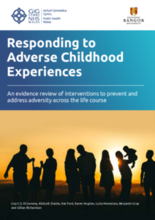Adverse childhood experiences (ACEs) are stressful events during childhood that can have a profound impact on an individual’s present and future health (Section 1.3). Growing up in the face of such adversities is recognised as an important public health concern in Wales and internationally (Welsh Government, 2017a; World Health Organization [WHO], 2014). Actions to prevent and mitigate ACEs and their associated harms are essential to improve population health for present and future generations (Bethell et al., 2017; Pachter et al., 2017).
In Wales, many sectors are working to identify and respond to adversity in order to improve outcomes for those who have experienced ACEs. Whilst a number of evidence-based interventions target specific types of adversity (e.g. domestic violence), we know that ACEs are strongly correlated (e.g. individuals exposed to adversity are often exposed to more than one type; Hughes et al., 2017). Thus, complex adversity requires a response which extends across sectors including health, social care, policing, education, community and others, and across the life course from early childhood through to adulthood.
To support innovation in addressing ACEs we have undertaken a review of evidence on common approaches to prevent ACEs and/or mitigate their negative impacts. Over 100 interventions were identified and collated across four common approaches: supporting parenting; building relationships and resilience; early identification of adversity; and, responding to trauma and specific ACEs (Chapter 3). Whilst the interventions vary in type, the review identified cross-cutting themes, which could be used to inform a whole system approach (spanning individual, family and community levels) to tackle ACEs across the life course, supporting the development of an ACE-informed approach (Chapter 4). The report concludes by highlighting current gaps in the evidence and suggests key areas for further work to tackle ACEs for our future generations (Chapter 5).
The report is not an exhaustive systematic evidence review of the interventions for specific ACE types, nor does it advocate any specific intervention, rather it seeks to present a summary of the research evidence and information on common approaches across the prevention of ACEs and mitigation of their impact. We hope the report will be a useful resource for service planners, practitioners and commissioners to support innovation and development towards an ACE-free future.

